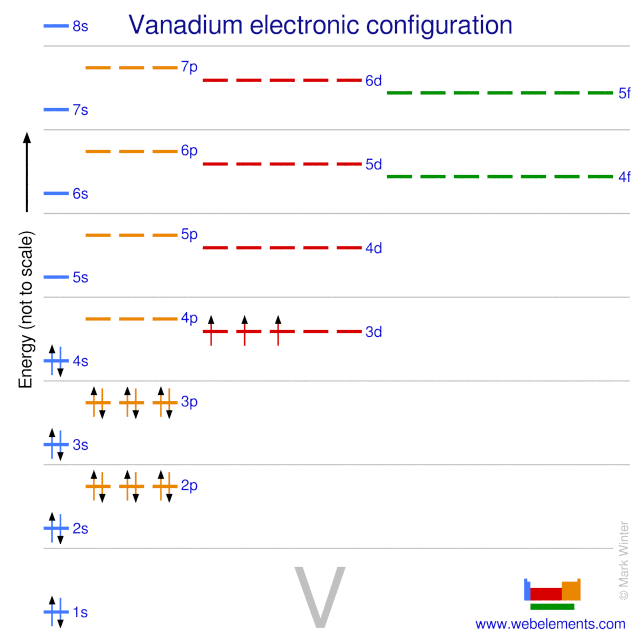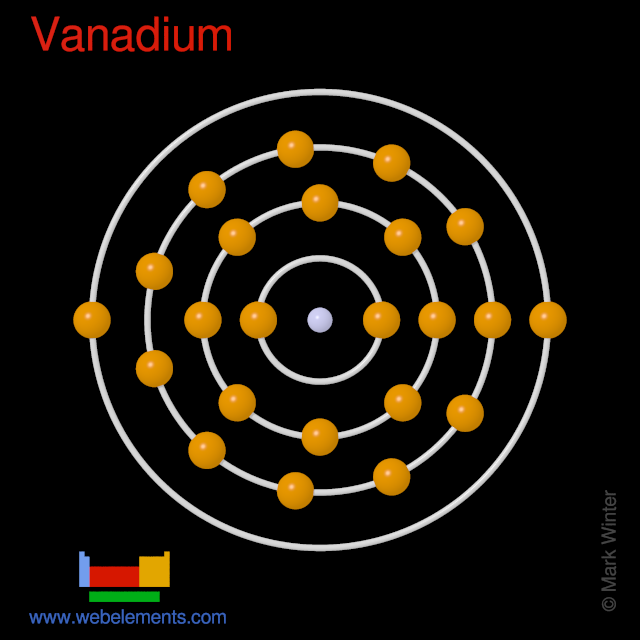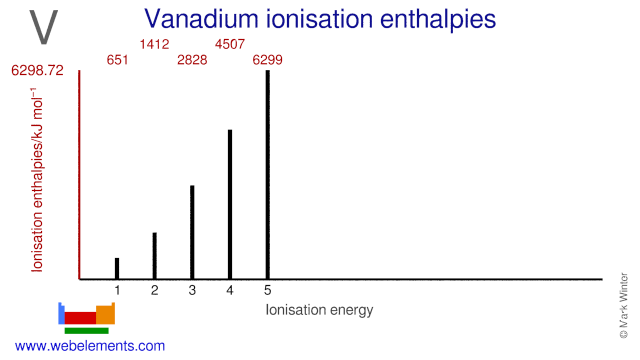Vanadium - 23V: properties of free atoms
Vanadium atoms have 23 electrons and the shell structure is 2.8.11.2.
The ground state electron configuration of ground state gaseous neutral vanadium is [Ar].3d3.4s2 and the term symbol is 4F3/2.


Atomic spectrum
A representation of the atomic spectrum of vanadium.
Ionisation Energies and electron affinity
The electron affinity of vanadium is 50.6 kJ mol‑1. The ionisation energies of vanadium are given below.
| Ionisation energy number | Enthalpy / kJ mol‑1 |
|---|---|
| 1st | 650.91 |
| 2nd | 1412.0 |
| 3rd | 2828.09 |
| 4th | 4506.7 |
| 5th | 6298.72 |
| 6th | 12360 |
| 7th | 14540 |
| 8th | 16750 |
| 9th | 19880 |
| 10th | 22240 |
| 11th | 24580 |
| 12th | 29770 (inferred) |
| 13th | 32450 |
| 14th | 86450 |
| 15th | 94290 |
| 16th | 103000 |
| 17th | 112000 |
| 18th | 121000 |
| 19th | 131000 |
| 20th | 143000 |
| 21st | 151449 |

Effective Nuclear Charges
The following are "Clementi-Raimondi" effective nuclear charges, Zeff. Follow the hyperlinks for more details and for graphs in various formats.
| 1s | 22.4256 | ||||||
|---|---|---|---|---|---|---|---|
| 2s | 16.18 | 2p | 19.07 | ||||
| 3s | 11.71 | 3p | 10.79 | 3d | 8.98 | ||
| 4s | 4.98 | 4p | (no data) | 4d | (no data) | 4f | (no data) |
| 5s | (no data) | 5p | (no data) | 5d | (no data) | ||
| 6s | (no data) | 6p | (no data) | ||||
| 7s | |||||||
References
These effective nuclear charges, Zeff, are adapted from the following references:
- E. Clementi and D.L.Raimondi, J. Chem. Phys. 1963, 38, 2686.
- E. Clementi, D.L.Raimondi, and W.P. Reinhardt, J. Chem. Phys. 1967, 47, 1300.
Electron binding energies
| Label | Orbital | eV [literature reference] |
|---|---|---|
| K | 1s | 5465 [1] |
| L I | 2s | 626.7 [3] |
| L II | 2p1/2 | 519.8 [3] |
| L III | 2p3/2 | 512.1 [3] |
| M I | 3s | 66.3 [3] |
| M II | 3p1/2 | 37.2 [3] |
| M III | 3p3/2 | 37.2 [3] |
Notes
I am grateful to Gwyn Williams (Jefferson Laboratory, Virginia, USA) who provided the electron binding energy data. The data are adapted from references 1-3. They are tabulated elsewhere on the WWW (reference 4) and in paper form (reference 5).
References
- J. A. Bearden and A. F. Burr, "Reevaluation of X-Ray Atomic Energy Levels," Rev. Mod. Phys., 1967, 39, 125.
- M. Cardona and L. Ley, Eds., Photoemission in Solids I: General Principles (Springer-Verlag, Berlin) with additional corrections, 1978.
- Gwyn Williams WWW table of values
- D.R. Lide, (Ed.) in Chemical Rubber Company handbook of chemistry and physics, CRC Press, Boca Raton, Florida, USA, 81st edition, 2000.
- J. C. Fuggle and N. Mårtensson, "Core-Level Binding Energies in Metals," J. Electron Spectrosc. Relat. Phenom., 1980, 21, 275.
